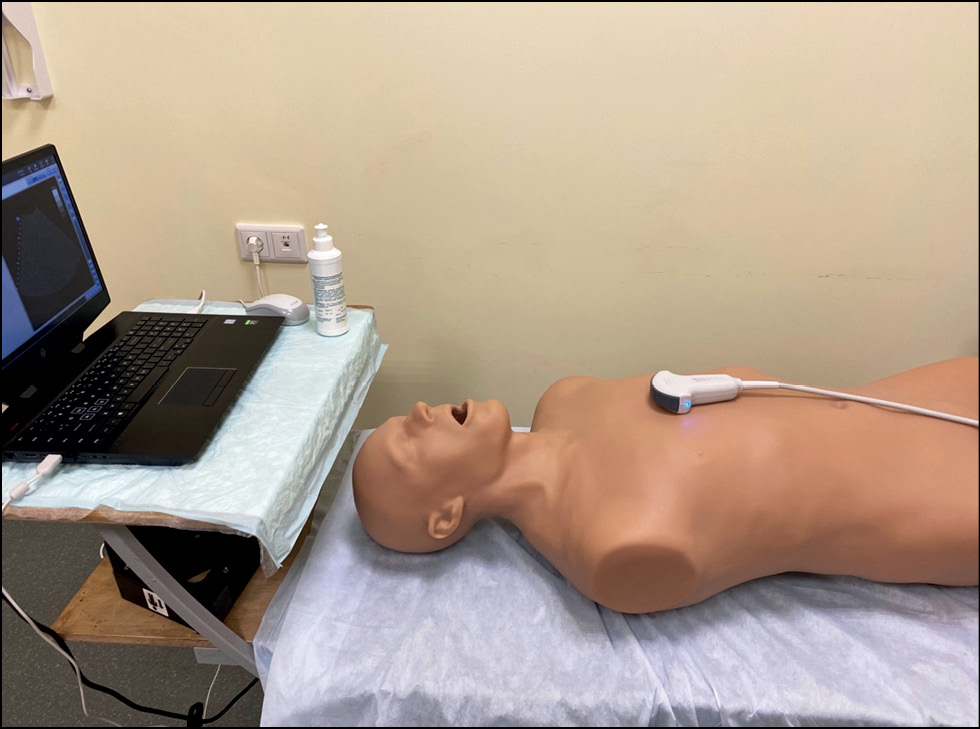在“超声诊断”专业教学过程中使用虚拟模拟器“Vimedix 3.2”的可行性
- 作者: Vasilev V.А.1, Kondrichina S.N.1
-
隶属关系:
- Petrozavodsk State University
- 期: 卷 5, 编号 1 (2024)
- 页面: 41-52
- 栏目: 原创性科研成果
- URL: https://journals.rcsi.science/DD/article/view/262948
- DOI: https://doi.org/10.17816/DD586551
- ID: 262948
如何引用文章
详细
论证。近年来,包括超声诊断在内的许多学科的教学方法和课程发生了变化,教学计划包括在各种虚拟和模拟设备上进行练习。在教学过程中使用此类技术的实践经验相当少,在这方面,国内外文献中有关这一主题的原创作品寥寥无几。
目的。本研究的目的是根据使用虚拟超声模拟器的工作结果,确定在“超声诊断”学科教学过程中使用该模拟器的可行性和算法;评估使用模拟器与传统教学方法相比的优缺点。
材料和方法。分析了在教学过程中使用虚拟模拟器“Vimedix 3.2”的结果,在该模拟器上进行了腹腔器官经腹超声检查、经胸超声心动图检查、大血管的三重扫描。研究的参与者包括26名“超声诊断”专业的住院医师和37名接受过职业进修课程的医生。
结果。在教学过程的初始阶段使用虚拟模拟器可以消除住院医师和学员在临床现场学习时遇到的许多问题。与使用超声波扫描仪和真正患者进行实践考试相比,在测试过程中使用模拟器似乎不太可取。
结论。在初始阶段使用模拟器来练习检查方法是可行的。建议在教学中开发和使用额外的教材和教学计划。虚拟模拟器的优点是在教学初期使用方便,掌握时间短,有大量病例数据库。已发现的非关键缺点需要在临床进一步培训中加以纠正。
作者简介
Valeri А. Vasilev
Petrozavodsk State University
Email: valerij-vasiljev@list.ru
ORCID iD: 0000-0001-7164-4274
SPIN 代码: 3582-0940
MD, Cand. Sci. (Medicine), Assistant Professor
俄罗斯联邦, PetrozavodskSvetlana N. Kondrichina
Petrozavodsk State University
编辑信件的主要联系方式.
Email: konsvet12@gmail.com
ORCID iD: 0000-0001-8472-9146
MD, Cand. Sci. (Medicine), Assistant Professor
俄罗斯联邦, Petrozavodsk参考
- Meller G. A typology of simulators for medical education. J Digit Imaging. 1997;10(Suppl. 1):194–196. doi: 10.1007/BF03168699
- Gaba DM. The future vision of simulation in health care. Quality and Safety in Health Care. 2004;13(Suppl. 1):2–10. doi: 10.1136/qshc.2004.009878
- Alinier G. A typology of educationally focused medical simulation tools. Medical Teacher. 2007;29(8):243–250. doi: 10.1080/01421590701551185
- Gorshkov MD, Nikitenko AI. Review of russian and world experience: usage of virtual simulators in training of endosurgeons. Virtual’nye tekhnologii v meditsine. 2009;1(1):15–18. EDN: QBAVGC doi: 10.46594/2687-0037_2009_1_18
- Gorshkov MD, Fedorov AV. Classification of the simulation equipment. Virtual’nye tekhnologii v meditsine. 2012;2(8):23–35. EDN: BJWHJB doi: 10.46594/2687-0037_2012_2_21
- Svistunov AA, editor. Simulation training in medicine. Moscow: Sechenov University Publishing; 2013. (In Russ). EDN: XVVEDZ doi: 10.46594/9785423501099
- Chalouhi GE, Bernardi V, Gueneuc A, et al. Evaluation of trainees’ ability to perform obstetrical ultrasound using simulation: challenges and opportunities. Am J Obstet Gynecol. 2016;214(4):525–528. doi: 10.1016/j.ajog.2015.10.932
- Hani S, Chalouhi G, Lakissian Z, Sharara-Chami R. Introduction of Ultrasound Simulation in Medical Education: Exploratory Study. JMIR Med Educ. 2019;5(2):13568. doi: 10.2196/13568
- Ovsiannikova LS, Shunkova SA, Kespleri EV. The importance of simulation technologies in improving the quality of training of specialists in ultrasound diagnostics. VI International (76 All-Russian) Scientific and Practical Conference “Topical Issues of Modern Medical Science and Public Health”. 2021;3:642–645.
- Freundt P, Nourkami-Tutdibi N, Tutdibi E, et al. Controlled Prospective Study on the Use of Systematic Simulator-Based Training with a Virtual, Moving Fetus for Learning Second-Trimester Scan: FESIM III. Ultraschall Med. 2023;44(4):e199–e205. doi: 10.1055/a-1984-8320
- Hatzl J, Böckler D, Hartmann N, et al. Mixed reality for the assessment of aortoiliac anatomy in patients with abdominal aortic aneurysm prior to open and endovascular repair: Feasibility and interobserver agreement. Vascular. 2023;31(4):644–653. doi: 10.1177/17085381221081324
- Kukla P, Maciejewska K, Strojna I, et al. Extended Reality in Diagnostic Imaging-A Literature Review. Tomography. 2023;9(3):1071–1082. doi: 10.3390/tomography9030088
- Vasilev VA, Vasileva AE. 3D/4D anatomical navigation in virtual ultrasound simulators. Actual issues of fundamental and clinical morphology: Proceedings of the International Scientific and Practical Conference, Tver, October 14, 2022. 2022:101–105. EDN: TWYHTL
- Bernstein IH. Likert Scale Analysis. Elsevier; 2005. doi: 10.1016/B0-12-369398-5/00104-3
- Dietrich CF, Lucius C, Nielsen MB, et al. The ultrasound use of simulators, current view, and perspectives: Requirements and technical aspects (WFUMB state of the art paper). Endosc Ultrasound. 2023;12(1):38–49. doi: 10.4103/EUS-D-22-00197
- Almestehi M, Alomaim W, Rainford L, et al. Role of the virtual reality simulator (ScanTrainer) as a multidisciplinary training tool in transvaginal ultrasound: A systematic review and narrative synthesis. Radiography (Lond). 2019;25(3):260–268. doi: 10.1016/j.radi.2018.12.009
- Pezel T, Dreyfus J, Mouhat B, et al. Effectiveness of SimulationBased Training on Transesophageal Echocardiography Learning: The SIMULATOR Randomized Clinical Trial. JAMA Cardiol. 2023;8(3):248–256. doi: 10.1001/jamacardio.2022.5016
- Tolsgaard MG, Todsen T, Sorensen JL, et al. International multispecialty consensus on how to evaluate ultrasound competence: a Delphi consensus surve. PLoS One. 2013;8(2):e57687. doi: 10.1371/journal.pone.0057687
补充文件















